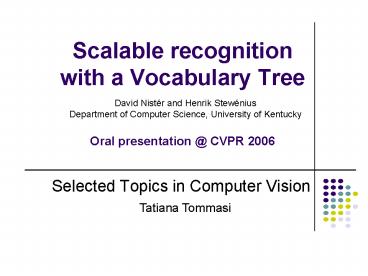Scalable recognition with a Vocabulary Tree - PowerPoint PPT Presentation
1 / 16
Title:
Scalable recognition with a Vocabulary Tree
Description:
Vocabulary Tree defined using an offline unsupervised ... plateaux. Results on 6376 images. Tatiana Tommasi - Scalable Recognition with a Vocabulary Tree ... – PowerPoint PPT presentation
Number of Views:560
Avg rating:3.0/5.0
Title: Scalable recognition with a Vocabulary Tree
1
Scalable recognition with a Vocabulary Tree
David Nistér and Henrik Stewénius Department of
Computer Science, University of Kentucky
Oral presentation _at_ CVPR 2006
- Selected Topics in Computer Vision
Tatiana Tommasi
2
The paper presents
- A recognition scheme that scales efficiently to a
large number - of objects.
- Vocabulary Tree defined using an offline
unsupervised training stage. - Hierarchical scoring based on Term Frequency
Inverse Document Frequency (TF-IDF). - Local features Maximally Stable Extremal Regions
(MSERs), Scale Invariant Feature Transform
(SIFT). - Extremely efficient retrieval a query takes 25ms
on a database - with 50000 images.
3
Building the Vocabulary Tree
k3 L2
4
Describing an Image
5
Describing an Image
6
Definition of Scoring
- Number of the descriptor vectors of each image
with a path along the node i (ni query, mi
database) - Number of images in the database with at least
one descriptor vector path through the node i (Ni
)
Ni2 m_Img11 m_Img21
Ni1 m_Img12 m_Img20
7
Definition of Scoring
- Weights are assigned to each node
- Query and database vectors are defined according
to their assigned weights - Each database image is given a relevance score
based on the normalized difference between the
query and the database vectors
8
Implementation of Scoring
- Every node is associated with an inverted file.
- Inverted files stored the id-numbers of the
images in which a particular node occurs and the
term frequency of that image. - decrease the fraction of images in the database
that have to be explicitely considered for a
query.
Img1, 1
Img2, 1
Img1, 2
9
Query
10
Database
- Ground truth database 6376 images
- Groups of four images of the same object but
under different conditions - Each image in turn is used as query image and the
three remaining images from its group should be
at the top of the query results
11
Results on 1400 images
- The curves show the distribution of
- how far the wanted images drop in
- the query rankings
- A larger (hierarchical) vocabulary improves
retrieval performance - L1 norm gives better retrieval performance than
L2 norm. - Entropy weighting is important at least for
smaller vocabularies
12
Results on 6376 images
Performance increases significantly with the
number of leaf nodes Performance increases
with the branch factor k
13
Results on 6376 images
Performance increases when the amount of training
data grows Performance increases at the
beginning when the number of training cycles
grows, then reaches a plateaux
14
Results on 1 million images
Performance with respect to increasing database
size. The vocabulary tree is defined with video
frames separate from the database.
- Entropy weighting of the vocabulary tree defined
with video independent from the database. - Entropy weighting defined using the ground truth
target subset of images.
15
Applications
16
Conclusions- Take home message
This methodology provides the ability to make
fast searches on extremely large databases. If
we can get repeatable, discriminative features,
then recognition can scale to very large
databases using the vocabulary tree and indexing
approach.
17
Definition of Scoring
- Weight wi - assigned to each node of the
vocabulary tree - constant
- based on entropy wi ln(N/Ni)
- N number of images in the database
- Ni number of images in the database with
at least one descriptor vector path through - the node i
- Frequency of occurence of node i in place of Ni
- Stop lists, wi is set to zero for the most
frequent and/or unfrequent nodes.
18
Building the Vocabulary Tree
- k-means clustering, k defining the branch factor
of the tree - L levels
- Determining the path of a descriptor means
performing kL dot products - The tree defines the visual vocabulary
- and an efficient search procedure.
k3 L1
L2
L3
L4

